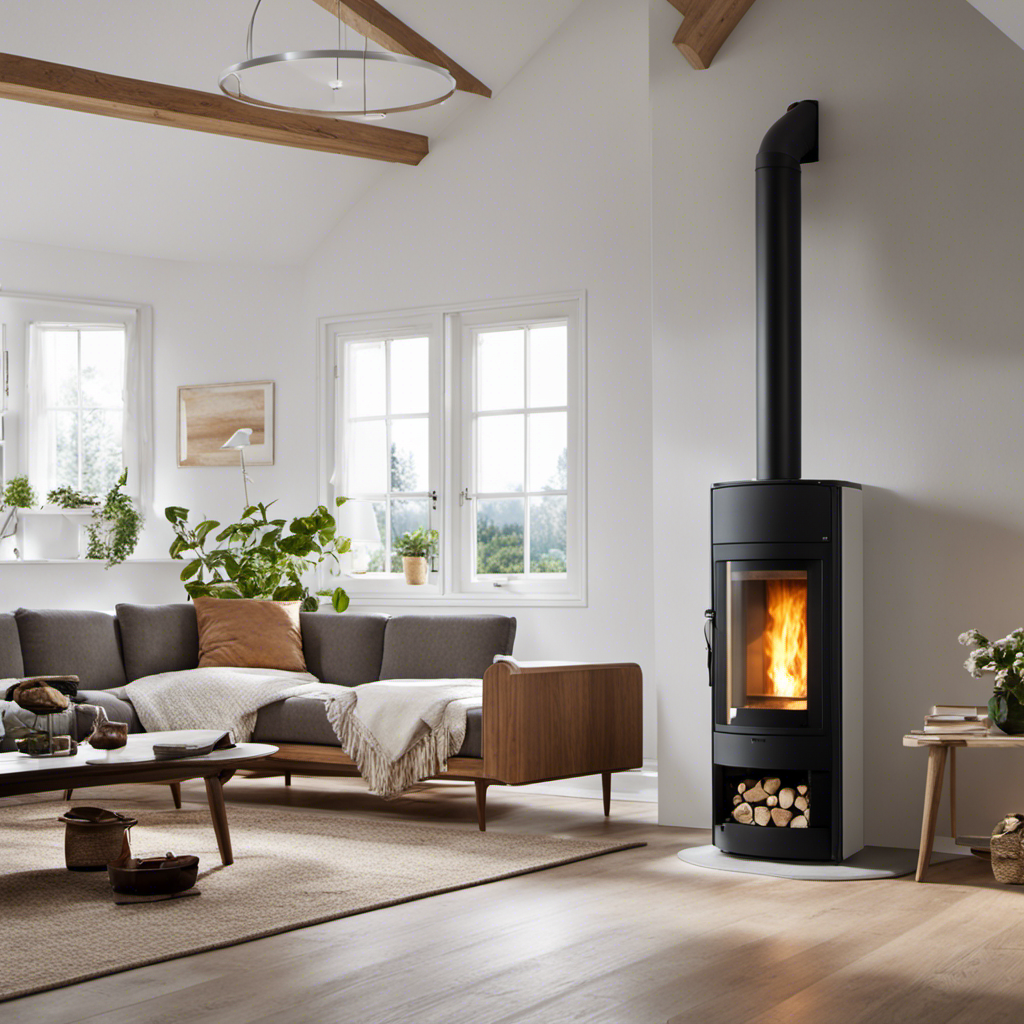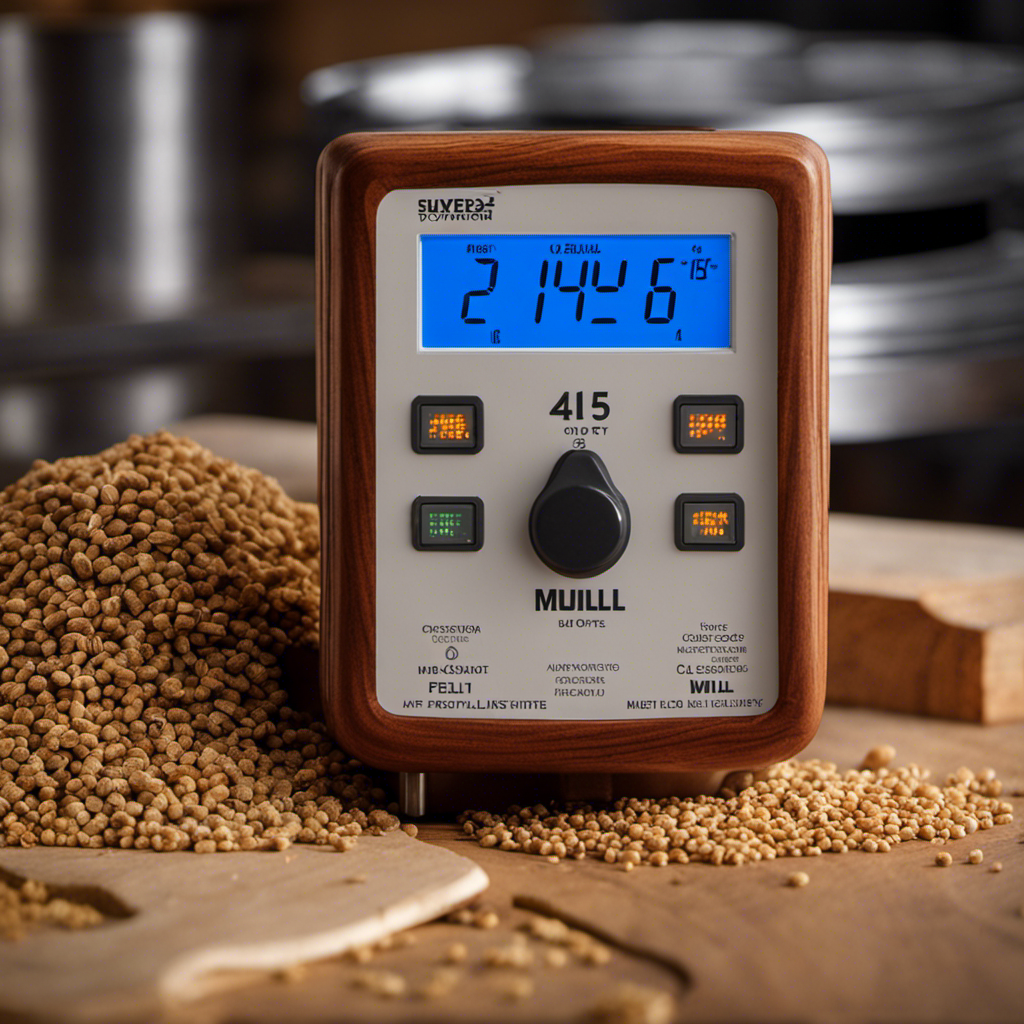As an individual who prioritizes safety and efficiency in home heating options, I frequently contemplate the inquiry, ‘How secure are wood pellet boilers?’
In this article, I will explore the various safety features and standards that govern these boilers.
From fire prevention measures to understanding carbon monoxide risks, proper ventilation, and overheating prevention, we will delve into the data and analyze the risk of combustion.
By assessing the safety record and emergency shutdown procedures, we can confidently evaluate the overall safety of wood pellet boilers.
Key Takeaways
- Wood pellet boilers have several safety features in place, such as flame detection sensors and automatic shutdown systems, to minimize fire risk.
- Carbon monoxide risks can be a serious concern, but installing carbon monoxide detectors and ensuring proper ventilation significantly lowers the risk of CO poisoning.
- Regular inspection, cleaning, and maintenance of wood pellet boilers are necessary to prevent blockages, reduce hazards, and ensure safe operation.
- Certification from reputable organizations and familiarity with emergency shutdown procedures are important for choosing and operating wood pellet boilers safely.
Safety Features of Wood Pellet Boilers
Wood pellet boilers come equipped with various safety features to ensure the well-being of users. Fire prevention is a top priority, and these boilers are designed with features such as flame detection sensors and automatic shutdown systems in case of fire. These measures help to minimize the risk of fire accidents and protect both the users and the surroundings.
Additionally, carbon monoxide detection is another crucial aspect of safety in wood pellet boilers. Carbon monoxide is a colorless and odorless gas that can be produced during the combustion process. To prevent the buildup of carbon monoxide levels, these boilers are equipped with detectors that can alert users if the gas reaches dangerous levels.
With these safety features in place, wood pellet boilers offer peace of mind and ensure the safety of those using them.
Moving on to fire prevention measures in wood pellet boilers…
Fire Prevention Measures in Wood Pellet Boilers
In this discussion, we will explore two important fire prevention measures in wood pellet boilers: fireproofing the pellet boiler interiors and installing automatic fire detection systems.
Fireproofing the interiors of pellet boilers involves using fire-resistant materials to protect the inner components from heat and flame. This measure helps to reduce the risk of fire incidents and ensures the safety of the boiler system.
Additionally, automatic fire detection systems play a crucial role in quickly identifying and alerting homeowners or building occupants about potential fire hazards in pellet boilers, enabling prompt action to prevent further damage.
Fireproofing Pellet Boiler Interiors
To ensure your safety, it is important to regularly inspect and maintain the fireproofing of the interior of your pellet boiler. Fireproofing materials are crucial in preventing fire incidents and minimizing potential damage. Safety regulations require that pellet boiler interiors be constructed with fire-resistant materials for added protection. These materials are designed to withstand high temperatures and prevent the spread of fire. Regular inspections and maintenance are necessary to ensure the effectiveness and compliance of fireproofing materials with safety standards.
Automatic Fire Detection Systems
Regular inspections and maintenance are crucial for ensuring the effectiveness of automatic fire detection systems in pellet boiler interiors. These fire detection technologies serve as early warning systems, allowing for timely response and preventing potentially catastrophic fires. The table below presents a comparison of different fire detection technologies commonly used in pellet boilers:
| Fire Detection Technology | Pros | Cons |
|---|---|---|
| Smoke detectors | – Highly sensitive to smoke particles | – Can be triggered by other sources of smoke such as cooking |
| Heat detectors | – Activated by high temperatures | – Slower response time compared to smoke detectors |
| Flame detectors | – Detects flames even in low-light conditions | – May not detect smoldering fires |
Understanding the strengths and limitations of each technology is essential for selecting the most suitable system for your pellet boiler. Transitioning to the subsequent section about ‘understanding carbon monoxide risks in wood pellet boilers’, it is important to consider the potential dangers associated with the operation of these systems.
Understanding Carbon Monoxide Risks in Wood Pellet Boilers
In this discussion, I’ll be analyzing the carbon monoxide dangers associated with wood pellet boilers. I’ll also explore ways to prevent CO poisoning and examine the safety measures that should be implemented in these types of boilers.
It’s important to understand the potential risks and take necessary precautions to ensure the safety of individuals using wood pellet boilers. By examining data and objective analysis, we can gain a better understanding of the dangers and develop effective safety measures to mitigate them.
Carbon Monoxide Dangers?
Carbon monoxide dangers can be a serious concern with wood pellet boilers. It is important to understand the potential risks associated with these systems. Here are some important points to consider:
-
Carbon monoxide detectors are essential: Installing carbon monoxide detectors near your wood pellet boiler can provide an early warning in case of a leak.
-
Recognizing carbon monoxide poisoning symptoms: Symptoms of carbon monoxide poisoning include headache, dizziness, nausea, confusion, and difficulty breathing. Being aware of these signs can help you take immediate action.
-
Regular maintenance is crucial: Ensuring that your wood pellet boiler is regularly inspected and maintained by a professional can help prevent carbon monoxide leaks.
-
Proper ventilation is key: Adequate ventilation in the area where the boiler is installed is important to prevent the accumulation of carbon monoxide.
Understanding the dangers of carbon monoxide is just the first step in ensuring the safety of wood pellet boilers. Now, let’s explore how to prevent carbon monoxide poisoning.
Preventing CO Poisoning
To prevent CO poisoning, it’s important for you to ensure proper ventilation in the area where your wood pellet boiler is installed. Carbon monoxide risks can arise when there is inadequate airflow, leading to the accumulation of this deadly gas. Ventilation is crucial because it helps to remove any harmful gases produced during the combustion process.
Without sufficient ventilation, carbon monoxide can build up and reach dangerous levels, posing a serious threat to your health and safety. By allowing fresh air to circulate, proper ventilation ensures that any carbon monoxide produced is effectively dispersed and diluted. This significantly reduces the risk of CO poisoning.
Now, let’s discuss the various safety measures for boilers, which can further enhance the overall safety of your wood pellet boiler system.
Safety Measures for Boilers
Make sure you regularly inspect and clean the vents and flues of your boiler system to prevent any blockages or obstructions. This is crucial for fire safety and proper installation of wood pellet boilers. Blocked vents and flues can lead to incomplete combustion, which increases the risk of carbon monoxide (CO) leaks.
It is important to ensure that the vents are clear and free from any debris, such as leaves or animal nests. Additionally, proper installation of the boiler system is essential for safe operation. This includes following manufacturer guidelines, using certified professionals, and complying with building codes.
Importance of Proper Ventilation in Wood Pellet Boilers
Proper ventilation is crucial for ensuring the safe operation of wood pellet boilers. Here are three reasons why it is important to prioritize ventilation in these systems:
-
Safety: Adequate ventilation helps prevent the build-up of harmful gases, such as carbon monoxide, which can be released during the combustion process. This ensures the health and safety of those using the boiler.
-
Efficiency: Proper ventilation allows for better combustion, resulting in more efficient and effective heating. It helps maintain the optimal air-to-fuel ratio, maximizing the boiler’s performance and reducing fuel consumption.
-
Longevity: Regular maintenance, including ventilation checks, can extend the lifespan of wood pellet boilers. Good ventilation prevents the accumulation of dust and debris, minimizing the risk of damage and costly repairs.
By prioritizing proper ventilation and regular maintenance, wood pellet boiler owners can enjoy the benefits of safe and efficient heating.
Now, let’s explore overheating prevention in wood pellet boilers.
Exploring Overheating Prevention in Wood Pellet Boilers
By ensuring adequate ventilation, you can prevent overheating in your wood pellet boiler. Overheating can occur when the temperature inside the boiler exceeds the recommended levels, leading to potential damage or even safety hazards.
To effectively control the temperature and prevent overheating, there are several techniques you can employ. One of the most important steps is to install a reliable thermostat that can accurately monitor and regulate the temperature. Additionally, regular cleaning and maintenance of the boiler is crucial to ensure proper airflow and heat transfer. It is also recommended to have a backup safety system in place, such as a pressure relief valve, to prevent excessive pressure buildup.
By implementing these overheating prevention techniques and maintaining effective temperature control, you can ensure the safe operation of your wood pellet boiler.
Now, let’s explore some maintenance tips for ensuring its safe operation.
Maintenance Tips for Ensuring Safe Operation of Wood Pellet Boilers
Regular cleaning is an essential aspect of maintaining the safe operation of wood pellet boilers. It helps to prevent the build-up of debris, such as ash and soot, which can lead to reduced efficiency and potential safety hazards.
In addition to regular cleaning, professional inspections are crucial in identifying any potential issues or malfunctions that may not be visible to the untrained eye. This ensures the long-term safety and optimal performance of wood pellet boilers.
Regular Cleaning Recommendations
You should clean your wood pellet boiler on a regular basis to ensure its safe operation. Regular maintenance is crucial for keeping your boiler functioning efficiently and minimizing the risk of accidents or malfunctions.
Cleaning recommendations for wood pellet boilers include removing ash and debris from the burn pot, cleaning the heat exchanger tubes, and inspecting the flue for any blockages. These tasks should be performed at least once a month, or more frequently depending on the usage and manufacturer’s instructions.
By keeping your boiler clean, you can prevent the build-up of ash and ensure proper airflow, which in turn improves the combustion process and reduces the risk of fire hazards. Regular cleaning also contributes to maintaining the boiler’s efficiency and prolonging its lifespan.
However, it’s important to note that regular cleaning is just one part of ensuring the safe operation of your wood pellet boiler. Professional inspections are also essential to identify any potential issues and address them promptly.
Importance of Professional Inspections
It’s crucial to have professional inspections conducted to ensure the safe operation and optimal performance of your wood pellet boiler. Here are some key reasons why:
-
Fire Extinguisher Placement: Professional inspections can assess the placement of fire extinguishers near your wood pellet boiler, ensuring they are easily accessible in case of emergency.
-
Importance of Regular Maintenance: Professional inspections can identify any potential issues or areas of concern that may require maintenance or repairs. Regular maintenance is vital to prevent accidents or malfunctions.
-
Safety Compliance: Professional inspections ensure that your wood pellet boiler meets all safety regulations and standards, giving you peace of mind knowing that your system is operating safely.
Regular professional inspections not only enhance the safety of your wood pellet boiler but also help in identifying and addressing common safety concerns.
Common Safety Concerns With Wood Pellet Boilers
One of the most common safety concerns with wood pellet boilers is the risk of carbon monoxide leaks. Proper installation and regular maintenance are crucial to ensure fire safety and minimize the risk of such leaks. Wood pellet boilers are designed to burn wood pellets efficiently, but if not installed correctly, they can pose a danger. A professional inspection can help identify any potential issues and ensure that the boiler is installed properly. To further understand the importance of fire safety and proper installation, let’s take a look at the following table:
| Common Safety Concerns | Risks |
|---|---|
| Carbon monoxide leaks | Health hazards, potential for asphyxiation |
| Improper installation | Fire hazards, decreased efficiency |
Evaluating the Risk of Combustion in Wood Pellet Boilers
To properly evaluate the risk of combustion in your wood pellet boiler, regular maintenance and professional inspections are essential. Here are some key aspects to consider when evaluating the risk:
- Fuel quality: Ensuring high-quality wood pellets with low moisture content and minimal impurities can significantly reduce the risk of combustion.
- Combustion chamber design: A well-designed combustion chamber can promote efficient and controlled combustion, minimizing the risk of overheating and potential fires.
- Automatic shutdown systems: Equipping your wood pellet boiler with automatic shutdown systems can quickly detect any combustion abnormalities and prevent potential accidents.
- Adequate ventilation: Proper ventilation is crucial for maintaining optimal combustion conditions and reducing the risk of carbon monoxide buildup.
Evaluating the risk of combustion is just one aspect of assessing the safety of wood pellet boilers. It is important to also consider safety standards and certifications to ensure the highest level of safety for your heating system.
Safety Standards and Certifications for Wood Pellet Boilers
When considering safety standards and certifications for your wood pellet boiler, you should look for reputable organizations that provide thorough evaluations and reliable certifications.
Fire safety is of utmost importance when it comes to wood pellet boilers, as they involve the combustion of biomass fuels. Safety regulations ensure that these boilers are designed and built to prevent fires and minimize the risk of accidents.
Organizations such as the Underwriters Laboratories (UL) and the CSA Group conduct comprehensive evaluations to ensure that wood pellet boilers meet the necessary safety standards. These certifications provide assurance that the boilers have undergone rigorous testing and comply with fire safety regulations.
By choosing a wood pellet boiler with these certifications, you can trust that your heating system meets the highest safety standards.
Now, let’s explore the emergency shutdown procedures for wood pellet boilers.
Emergency Shutdown Procedures for Wood Pellet Boilers
When it comes to wood pellet boilers, knowing the emergency shutdown procedures is essential for ensuring safety. Here are some troubleshooting tips to keep in mind:
-
Familiarize yourself with the manufacturer’s instructions: Each boiler may have specific shutdown procedures, so it’s important to thoroughly read and understand the manual.
-
Identify the emergency shutdown switch: Locate the switch that can quickly shut down the boiler in case of an emergency. It should be easily accessible and clearly labeled.
-
Practice regular maintenance: Proper maintenance can help prevent emergencies. Regularly inspect and clean the boiler to ensure it is functioning optimally.
-
Contact a professional if needed: If you encounter any issues or are unsure about the shutdown procedures, it is best to consult a qualified technician for assistance.
Understanding these emergency shutdown procedures and troubleshooting tips can contribute to the safe operation of wood pellet boilers.
Now, let’s move on to assessing the safety record of these boilers.
Assessing the Safety Record of Wood Pellet Boilers
Assessing the safety record of these boilers can provide you with valuable insights into their performance and reliability. When it comes to wood pellet boilers, it is important to consider the potential risks, such as carbon monoxide poisoning.
Carbon monoxide is a colorless and odorless gas that can be deadly if not detected early. Therefore, safety regulations for wood pellet boilers are in place to mitigate these risks. These regulations require proper installation, regular maintenance, and the use of carbon monoxide detectors.
Additionally, manufacturers are often required to meet specific safety standards to ensure the safe operation of their boilers. By evaluating the safety record of wood pellet boilers, you can make informed decisions about their usage, helping to protect yourself and others from potential harm.
Frequently Asked Questions
Are Wood Pellet Boilers Safe to Use in Residential Homes?
I’ve found that wood pellet boilers are generally safe for residential homes. They have a low environmental impact and can be cost-effective in the long run. However, it’s important to follow proper maintenance and safety protocols to ensure safe operation.
Can Wood Pellet Boilers Cause Fires or Explosions?
Wood pellet boilers have a low risk of fire or explosions due to safety measures like temperature controls and automatic shutdowns. Regular maintenance and proper installation further minimize these risks for safe operation.
How Do Wood Pellet Boilers Prevent Carbon Monoxide Leaks?
To ensure safety and prevent leakage, wood pellet boilers are equipped with various safety features. These include sensors to detect carbon monoxide levels and automatic shut-off systems to prevent leaks and potential hazards.
What Are the Risks of Inadequate Ventilation in Wood Pellet Boilers?
The risks of inadequate ventilation in wood pellet boilers include increased carbon monoxide levels and potential fire hazards. Poor installation and lack of regular cleaning can contribute to these risks, highlighting the importance of proper maintenance.
How Often Should Maintenance Be Performed on Wood Pellet Boilers to Ensure Safety?
Maintenance on wood pellet boilers should be performed regularly to ensure safety. Common procedures include cleaning the ash, checking the flue, and inspecting the system for any signs of wear or damage.
Conclusion
In conclusion, after analyzing the safety features, fire prevention measures, and understanding carbon monoxide risks, it is clear that wood pellet boilers are generally safe to use. Ventilation, overheating prevention, and combustion risks are also important factors to consider. Additionally, safety standards and certifications, as well as emergency shutdown procedures, contribute to the overall safety of these boilers. It is important to remember the importance of proper maintenance and safety protocols. With these precautions in place, you can rest assured that your wood pellet boiler will keep you warm and safe. Just like a cozy fire in the hearth on a cold winter’s night.











